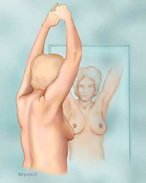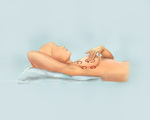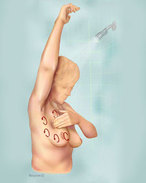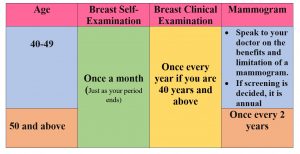Screening of breast cancer is performed in asymptomatic women with the aim of detecting breast cancer that is not yet clinically evident. This allows breast cancer to be detected earlier, investigated and treated early.
Breast Screening Methods:
It includes-
a.) Breast physical examination :
- Breast self-examination- by woman herself.
- Clinical breast examination – by doctor or breast specialist nurse.
b.) Screening Mammography.
A). Breast self-examination (BSE):
- Breast self-examination (BSE) is recommended for any change in the normal look or feel of your breasts on a monthly basis.
- A good way to remember to do this is to check just as your period ends. If you are no longer menstruate, choose a date each month, to make it easy remember the date of your birthday in each month.
- Report any changes to your doctor such as redness, swelling, presence of a lump, skin changes or nipple discharge. A self-exam should be in addition to your annual breast exam from your doctor.
How to do a breast self-exam: (The five easy steps)
Step 1:
- Begin by looking at your breasts in the mirror with your shoulders straight and your arms on your hips.
- In this position, turn slowly from side to side and look for:
- Changes in size or shape of your breasts
- Dimpling, puckering, or bulging of the skin
- A nipple that has changed position or an inverted nipple
 Step-2:
Step-2:
- Now, raise your arms and look for the same changes.
Step-3:
- While you’re at the mirror, look for any signs of fluid coming
out of one or both nipples (this could be a watery, milky, or yellow fluid or blood).
 Step-4:
Step-4:
Feel for the changes lying down
- Put a small pillow under your right shoulder
- Place your right hand under your head
- Use the pulp of your left fingers to feel for any lump in your right breast.
- Feel for the changes lying down
- First, feel the armpit
- Then start on the outside edge of your breast & feel round the whole breast in smaller and smaller circles
- Finally feel behind the nipples itself.
 Step-5:
Step-5:
Finally, feel your breasts while you are standing or sitting. Many women find that the easiest way to feel their breasts is when their skin is wet and slippery,
B). Clinical Breast Examination(CBE):
 A CBE should be performed by a health care provider well-trained in the technique (this may be a doctor,specialist nurse or other medical staff) once every year if you are 40 years and above.
A CBE should be performed by a health care provider well-trained in the technique (this may be a doctor,specialist nurse or other medical staff) once every year if you are 40 years and above.
- The provider will visually check your breasts while you are sitting up and physically examine your breasts while you are lying down.
- The National Comprehensive Cancer Network (NCCN) recommends a trained provider carefully feel your breasts, underarm and the area just below your clavicle (breast bone) for any changes or abnormalities (such as a lump).
- Sometimes changes in the breast may not be due to cancer and diagnostic tests may be performed to assess these changes.
C). Screening Mammography:
- Screening with mammography uses low-powered X‐ray imaging to find breast cancer before a lump can be felt.
- The goal is to treat cancer earlier, when a cure is more likely.
- Usual screening mammography involve talking X-ray images with the breast compressed between two plates with two views taken- cranio caudal or horizontal and mediolateral oblique or diagonal. Additional angles and magnified views may be taken if there are areas of concern.
- It can detect the presence and position of abnormalities and help in the diagnosis of breast problems, including cancer.
 “The biggest misconception about mammography is that it picks up every breast cancer. In fact, mammography misses at least 10% of breast cancer. So if you feel a lump that doesn’t show up on a mammogram, bring it to your doctor’s attention. Get it evaluated.”
“The biggest misconception about mammography is that it picks up every breast cancer. In fact, mammography misses at least 10% of breast cancer. So if you feel a lump that doesn’t show up on a mammogram, bring it to your doctor’s attention. Get it evaluated.”
— Susan Greenstein Orel, M.D.
Recommendations for Breast Screening: 
Conclusion:
The risk of breast cancer increases with age. Women with risk factors such as a family history of breast cancer should discuss with their doctors when to go for and the interval of regular screening. If it’s detected early, treatment is more successful and there’s a good chance of recovery.
Writer:
Dr. Samia Mostary
MS Thesis Part (General Surgery)
BIRDEM General Hospital, Shahbag, Dhaka
